Pre-Calculus 11 Student Edition Chapter 2 Trigonometry
Page 100 Problem 1 Answer
Given: the ratio of the sine of an angle to the length of its opposite side is constant.
To determine: that the statement is true by drawing an oblique triangle.
Summary: we will first sketch the triangle and then determine the ratio of any two sides of the triangle.
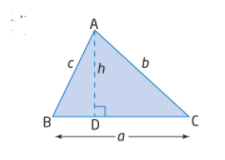
Consider an oblique triangle ABC, draw an altitude AD⊥BC and let AD=h.
Now, in △ABD, sinB=h/c⇒h=csinB
And in △ACD, sinC=h/b⇒h=bsinC
From the above equations, we can say that the given statement is true as the ratio of sine of an angle to the length of its opposite side is constant.
Thus, we can conclude that the given statement is true as the ratio of sine of an angle to the length of its opposite side is constant.
Read and Learn More Precalculus Textbook Mcgraw Hill Answers
Page 100 Problem 2 Answer
To draw: an oblique triangle and label them.
Draw a triangle which is not a right triangle and name it as △ABC with sides as a,b,c. Then draw an altitude from B to AC and let its height be h.
Thus, the required triangle be

Hence, the required traingle is
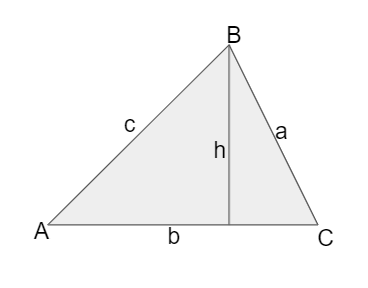
Page 101 Problem 3 Answer
To write: the trignometric ratio for sinA and sinC and determine how are two equations are same.
Summary: we will first consider two right triangles in one oblique triangle and then write the trignometric ratio.
Precalculus Textbook Mcgraw Hill Answers
Consider the figure as,
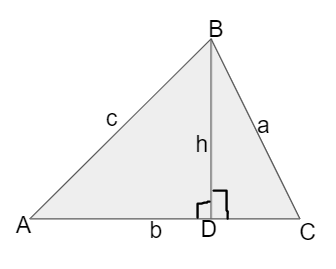
Now, in △BAD,sinA=h/c
And in △BCD,sinC=h/a
Thus, we can say that both the equations for sinA and sinC are equal to the ratio of length of the opposite side that is altitude and the hypotenuse.
Hence, we can conclude that both the equations are equal to the ratio of length of the opposite side that is altitude and the hypotenuse.
Page 101 Problem 4 Answer
To eliminate: h from both the equations and form one equation.
From step 4, we have, h=c sin A and h=asinC.
We can relate both the above equations as they are equal to h as follows,
C sin A =a sin C
Thus, the required equation is csin A=asinC.
Page 101 Problem 5 Answer
To divide: the equation in step 5(a) by ac.
The equation obtained in step 5(a) is c sinA=asinC.
On dividing both the sides of the equation by ac, we get,
⇒csinA
⇒csinA
ac⇒sinA
a=asinC
=asinC/ac
=sinC/c
Hence, the equation becomes sinA/a=sinC/c.
Page 104 Problem 6 Answer
Given: The measures of ∠L=64∘,l=25.2cm,m=16.5cm.
To determine: the measure of ∠N.
Summary: WE will first sketch the diagram of the triangle LMN and then we will use the sine law to find the measure of the ∠M and then we will use the angle sum property to find the remaining angle.
Precalculus Textbook Mcgraw Hill Answers
Consider the diagram of the △LMN,

Use the sine law to determine the measure of ∠M
⇒sinM/m
⇒sinM
⇒sinM
⇒M
⇒M
=sinL/l=sin(64∘)(16.5)/25.2
=0.5884
=sin−1/(0.5884)≈36∘
Use the angle sum property to find the measure of the ∠N
⇒∠N
=180∘−(36∘+64∘)
=180∘−100∘
=80∘
Hence, therequired measure of the ∠N=80∘.
Page 107 Problem 7 Answer
Given:∠A=39∘ and sides a=14cm , b=10cm
We have to find the value of ∠B,∠C and side c.
Apply sine law to find the remaining angles and sides of ΔABC.
First find the value of ∠B with the help of sinA/a=sinB/b.
Substitute 14 for a, 10 for b and 39∘
for A into sinA/a=sinB/b.
sin39∘/14 =sinB/10
Simplify further by multiplying 10 both side.
sin39∘/14×10=sinB/0.63
14×10=sinB
0.4495≈sinB
Simplify further to find the value of B.
Precalculus Textbook Mcgraw Hill Answers
sin−1/(0.4495)=B
26.71≈B
So ∠B=27∘, to the nearest degree.
Now use angle sum property to find the value of ∠C.
∠A+∠B+∠C=180∘
39∘+27∘+∠C=180∘
∠C=180∘−39∘−27∘
∠C=114∘
Substitute ∠A=39∘,∠C=114∘ and a=14 into sinA
a=sinC/c.
sin39∘/14=sin114∘/c
Simplify further to find the value of c.
c=sin114/sin39∘/14
c≈20.32
So, c=20,to the nearest unit.
Therefore, the values of remaining angles and sides of ΔABC are ∠B=27∘,∠C=114∘ and c=20cm.
Page 108 Problem 8 Answer
Given:a/sin35∘=10/sin40∘
we have to find the value of side a.
Multiply sin35∘ both side of a/sin35∘=10/sin40∘.
A/sin35∘×sin35∘=10
sin40∘×sin35∘/a=10
sin40∘×sin35∘/a≈8.92
So, a=8.9, to the nearest number.
Therefore, the value of side a=8.9.
Page 108 Problem 9 Answer
Given: b/sin48∘=65/sin75∘
We have to find the value of side b.
Multiply sin48∘both side of b/sin48∘=65/sin75∘.
B/sin48∘×sin48∘=65
sin75∘×sin48∘b=65
sin75∘×sin48∘b=50.0 therefore, the value of side b=50.0.
Precalculus Textbook Mcgraw Hill Answers
Page 108 Problem 10 Answer
Given: sinθ/12=sin50∘/65
we have to find the value of θ.
Multiply 12 both side of sinθ12=sin50∘/65.
Sinθ/12×12=sin50∘
65×12sinθ=sin50∘×12
65/sinθ=0.1414
θ=sin−1/(0.1414)
θ=8.13∘
So, θ=8∘, to the nearest unit.
Therefore, the value of θ=8∘.
Page 108 Problem 11 Answer
Given: sinA/25=sin62∘/32
we have to find the value of angle A.
Multiply 25 both side of sinA/25=sin62∘/32.
sinA/25×25=sin62∘/32×25
sinA=sin62∘/32×25
A=sin−1/(sin62∘32×25)
A=43.6∘
So, A=44∘, to the nearest number.
Therefore, the value of angle A=44∘.
Page 108 Problem 12 Answer
Given triangle ABC with ∠A=35o ,∠B=88o, AC=44 m
We have to find the length of side AB.
In given triangle ∠A=35∘ ,∠B=88∘.Subtract given angles from the sum of all angles of triangle, 180∘ to obtain the ∠C.
∠C=180∘−35∘−88∘
∠C=57∘
Using sine formula a/sin A=b/sin B=c/sin C
Substitute 88∘ for B, 57∘ for C and 44 for b into last two fractions, that is b/sinB=c/sinC.
44/sin88∘=c/sin57∘
c=sin57∘×44/sin88
c=0.838×44/0.999
c=36.90m
Hence length of side AB = 30.90m
Precalculus Textbook Mcgraw Hill Answers
Page 108 Problem 13 Answer
Given triangle ABC with ∠A=52o ,∠C=118o, CB=45 m
We have to find the length of side AB.
In given triangle, ∠A=52o ,∠C=118o, CB=45 m
Using sine formula a/sin A=b/sin B=c/sin C
Substitute 52∘ for A, 118∘ for C and 45 for a into last two fractions, that is a/sin A=c/sin C.
45/sin52∘=c/sin118∘
c=sin118∘×45sin52∘
c=0.882×45/0.788
c=50.36m
Hence length of side AB = 50.36m
Page 108 Problem 14 Answer
In the given triangle ABC,∠B=62o, AB=28 m, AC=31 m.We have to find the angle of ∠C .
Given triangle ABC with ∠B=62o, AB=28 m, AC=31 m .Using sine formula a/sinA=b/sinB=c/sinC.
Substitute 62∘ for B, 28 for c and 31 for b into last two fractions, that is b/sin B=c/sin C and solve to get the result.
31/sin62∘=28/sinC
sinC=sin62∘×28/31
sinC=0.882×28/31
sinC=0.796
C=sin−1/(0.796)
C=52.75∘
So, C=53∘to the nearest unit.
Therefore, the value of ∠C=53∘
Page 108 Problem 15 Answer
In the given triangle ABC, ∠B=98o, AC=17.5 m, BC=15 m.We have to find the angle of ∠A.
In the given triangle ABC, ∠B=98o, AC=17.5 m, BC=15 m.Using sine formula, a/sinA=b/sinB=c/sinC.Substitute 98∘
for B, 17.5 for b and 15 for a into first two fractions, that is a
sinA=b/sinB.
15/sinA=17.5/sin98∘
sinA=sin98∘×15/17.5
sinA=0.99×15/17.5
sinA=0.848
A=sin−1/(0.848)
A=57.994∘
So, A=58∘to the nearest unit.
Therefore, the value of ∠A=58∘
Precalculus Textbook Mcgraw Hill Answers
Page 108 Problem 16 Answer
In the given triangle ABC, ∠B=67o, AB=13 m, AC=12 m
We have to find ∠A, ∠C and BC.
In the given triangle ABC, ∠B=67o, AB=13 m, AC=12 m.
Using sine formula, a/sinA=b/sinB=c/sinC.Substitute 67∘
for B, 13 for c and 12 for b into last two fractions, that is b/sinB=c/sinC and solve to get ∠C.
12/sin67∘=13/sinC
sinC=13×sin67∘/12
sinC=13×0.92/12
sinC=0.996
C=sin−1/(0.996)
C=84.873∘
So, ∠C=85∘ to the nearest unit.
Use the total sum of all angles of a triangle are equal to 180∘, that is ∠A+∠B+∠C=180∘.Substitute 67∘
for ∠B and 85∘ for ∠C into ∠A+∠B+∠C=180∘ and solve to obtain ∠A.
∠A+67∘+85∘=180∘
∠A=180∘−67∘−85∘
∠A=28∘
Use sine formula, a/sinA=b/sinB=c/sinC to determine the length of BC.Substitute 28∘
for A, 67∘ for B and 12 for b into first two fractions, that is a/sinA=b/sinB.
A/sin28∘=12/sin67∘
a=12×sin28∘
sin67∘a=12×0.469/0.92
a=6.117
So, a=6.1 m to the nearest unit.
Hence , ∠A=28∘, ∠C=85∘ and the length of side BC=6.1 m.
Page 108 Problem 17 Answer
In given figure ∇ABC, ∠A=42˚ , ∠B=84˚ , AC = 50m
we have to find ∠C , AB and BC.
Let BC = a , AC = b and AB = c
∵ ∠A+∠B+∠C=180˚
⇒42˚+84˚+∠C=180˚
⇒∠C=180˚−42˚−84˚
⇒∠C=180˚−126˚
⇒ ∠C=54˚
Using sine law ,A/sinA=b/sinB
⇒a/sin42˚
=50/sin84˚
⇒a=50×sin42˚
sin84˚⇒a=50×0.6691/0.9945
⇒a = 33.6 m
Again , using sine law ,
B/sinB=c/sinC ⇒50
sin84˚=c
sin54˚ ⇒c=50×sin54˚
sin84˚⇒c=50×0.8090/0.9945
⇒c=40.67 or , c = 40.7 m
Hence , ∠C=54˚ and the length of sides AB = 40.7 m and BC = 33.6 m
Page 108 Problem 18 Answer
In given figure ΔABC,∠A=22˚ , ∠C=39˚ and side AC = 29mm
we have to find ∠B and sides AB and BC.
Let , BC = a , AC = b and AB = c
∵∠A+∠B+∠C=180˚
⇒22˚+∠B+39˚=180˚
⇒∠B=180˚−22˚−39˚
⇒∠B=180˚−61˚
∠B=119˚
By using sine law , A/sinA=b/sinB ⇒a/sin22˚
=29/sin119˚
⇒a=29×sin22˚/sin119˚
⇒a=29×sin22˚/sin(180˚−61˚)
⇒a=29×sin22˚/sin61˚
⇒a=29×0.3746/0.8746
⇒a=12.42 or , a = 12.4 mm
Again , by using sine law,
A/sinA=c/sinC
⇒12.4/sin22˚
=c/sin39˚
⇒c=12.4×sin39˚/sin22˚
⇒c=12.4×0.6293/0.3746
⇒c=20.83 or , c = 20.8 mm
Hence , ∠B=119˚ and the length of sides AB = 20.8 mm and BC = 12.4 mm.
Precalculus Textbook Mcgraw Hill Answers
Page 108 Problem 19 Answer
In give figure ΔABC ,∠A=48˚ ,∠C=61˚ and AC = 21cm
we have to find ∠B , AB and BC.
Let , BC = a , AC = b and AB = c
∵∠A+∠B+∠C=180˚
⇒48˚+∠B+61˚=180˚
⇒∠B=180˚−48˚−61˚
⇒∠B=180˚−109˚
⇒∠B=71˚
By using sine law ,
A/sinA=b/sinB ⇒a/sin48˚
=21/sin71˚⇒a=21×sin48˚
sin71˚ ⇒a=21×0.7431/0.9455
⇒a=16.5cm
Again , by using sine law ,
B/sinB=c/sinC ⇒21
sin71˚=c/sin61˚ ⇒c=21×sin61˚
sin71˚ ⇒c=21×0.8746/0.9455
⇒c=19.4cm
Hence , ∠B=71˚and length of sides BC = 16.5 cm and AB = 19.4 cm.
Page 108 Problem 20 Answer
In given ∇ABC , ∠A=57˚ ,∠B=73˚ and AB = 24 cm
firstly, sketch triangle ABC then, we will find the length of AC.

Sketching triangle ABC with ∠A=57˚ , ∠B=73˚ and AB = 24cm and AC =x cm
∵ ∠A+∠B+∠C=180˚
⇒57˚+73˚+∠C=180˚
⇒∠C=180˚−57˚−73˚
⇒∠C=180˚−130˚
∠C=50˚
Now , by using sine law
B/sinB=c/sinC ⇒x/sin73˚=24
sin50˚ ⇒x=24×sin73˚
sin50˚ ⇒x=24×0.9563/0.7660
⇒x=29.96
or x = 30cm
or AC = 30 cm
Hence , length of side AC = 30 cm
Page 108 Problem 21 Answer
In given ΔABC , ∠B=38˚ ,∠C=56˚ and BC = 63cm
firstly , sketch triangle ABC then , we have to find the length of AB .
Sketching triangle ABC with ∠B=38˚ , ∠C=56˚ and BC =63cm and AB = x cm
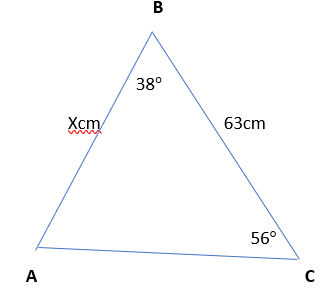
∵∠A+∠B+∠C=180˚ ⇒∠A+38˚+56˚=180˚
⇒∠A=180˚−94˚
⇒∠A=86˚
Now , by using sine law ,
A/sinA=c/sinC ⇒63
sin86˚=x/sin56˚ ⇒x=63×sin56˚
sin86˚ ⇒x=63×0.8290/0.9976
⇒x=52.35 or , x = 52.4 cm
Hence , length of side AB= 52.4 cm
Precalculus Textbook Mcgraw Hill Answers
Page 108 Problem 22 Answer
Given triangle ABC with ∠A=50 ,∠B=50 , AC=27m
We have to find the length of side AB.
In given triangle ∠A=500 ,∠B=500

Then ∠C=180∘−50∘−50∘
=800
Using sine formula A/sinA=b/sin B=c/sin C
From last two fractions
B/sinB=c/sin C
27/sin500=c/sin800
c= sin800×27/sin500
c= 0.984 ×27/0.766
c=34.68m
Hence length of side AB = 34.68m

Page 108 Problem 23 Answer
Given triangle ABC with ∠A=230, ∠C=780 , and AB =15 cm.
We have to find the length of side BC.

Since sum of all angles of triangle = 180
So ∠A+∠B+∠C=180
23+∠B+78 = 180
∠B= 180−101
∠B=790
Now using sine formula
A/sin A=b/sin B=c/sin C
Now using first and third fraction
A/sin230=15/sin780
a= 15×sin230/sin780
a= 15×0.390/0.978
a= 5.98cm
Hence a= length of side BC =5.98cm
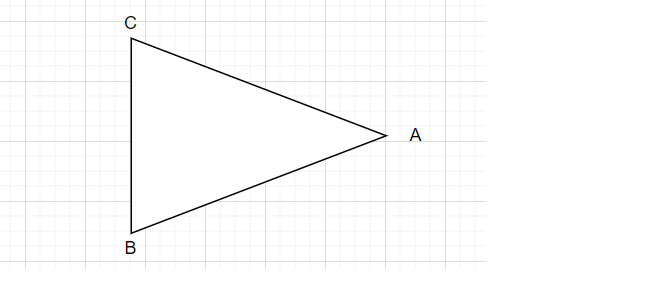
Page 108 Problem 24 Answer
Given triangle ABC ∠A=390 ,a= 10cm , b=14cm
We have to determine whether there is no solution, one solution, or two solutions.
Given ∠A=39∘ ,a= 10 , b=14
h= b sin A =14×sin390
=14×0.629
=8.810cm
Here angle A is acute angle and h<a<b
So according to result this triangle has two solutions .
Hence given triangle has two solutions .
Page 108 Problem 25 Answer
Given a triangle ABC with ∠A = 123,a =23 cm ,b= 12cm
We have to determine whether there is no solution, one solution, or two solutions.
Since here angle A is =123 which is obtuse angle and a>b
So according to result given triangle has one solution .
Hence given triangle has one solution .
Page 108 Problem 26 Answer
Given triangle ABC with ∠A=1450 , a =18 cm , b= 10 cm.
We have to determine whether there is no solution, one solution, or two solutions.
Since here angle∠A=145∘ is obtuse angle and a>b i.e 18>10
So according to result given relation has one solution .
Hence given triangle has one solution .
Page 108 Problem 27 Answer
Given triangle ABC with ∠A=124∘, a=1,b=2
We have to determine whether there is no solution, one solution, or two solutions.
Here the angle ∠A=124 is obtuse and a<b i.e, 1<2
So according to result given relation has no solution .
Hence given triangle has no solution.
Page 108 Problem 28 Answer
Given:

If h is an altitude. then how ∠A, sides a and b, and h are related
We have the diagram.

sinA=h/b
h=bsinA
Then, from the diagram, bsinA<a<b

Then, from the diagram, bsinA<a<b
Page 108 Problem 29 Answer
Given: In the diagram h is an altitude

To Describe how ∠A, sides a and b, and h are related in each diagram.
We have the diagram

sinA=h/b
h=bsinA
Then, from the diagram, bsinA<a<b.

Hence, from the diagram, bsinA<a<b.
Page 108 Problem 30 Answer
Given: In the diagram, h is an altitude

To Describe how ∠A, sides a and b, and h are related in each diagram.
We have the triangle

sinA=h/b
h=bsinA
Also, from the diagram, a=bsinA.
Hence, the ∠A, sides a and b, and h are related in the diagram as from the diagram, a=bsinA.

Page 108 Problem 31 Answer
Given: In each diagram, h is an altitude
To Describe how ∠A, sides a and b, and h are related in each diagram.
We have the triangle

So, sinA/h=h/b=bsinA
From the diagram, a≥b>bsinA

Hence, the ∠A, sides a and b, and h are related in the diagram as From the diagram, a≥b>bsinA

